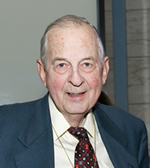About
26 June 2013
The Optical Society Mourns the Loss of James P. Gordon
FOR IMMEDIATE RELEASE
Contact:
Lyndsay Meyer
The Optical Society
+1.202.416.1435
lmeyer@osa.org
The Optical Society Mourns the Loss of James P. Gordon
 WASHINGTON, June 26, 2013—The Optical Society (OSA) today expressed its condolences at the loss of James P. Gordon, an OSA Honorary Member and Fellow Emeritus. Gordon, who was known for his contributions to quantum electronics and photonics, including the first demonstration of the maser, passed away June 21. He was 85.
WASHINGTON, June 26, 2013—The Optical Society (OSA) today expressed its condolences at the loss of James P. Gordon, an OSA Honorary Member and Fellow Emeritus. Gordon, who was known for his contributions to quantum electronics and photonics, including the first demonstration of the maser, passed away June 21. He was 85.
“Jim’s contributions to optics and photonics, beginning in the 1950s with his co-invention of the maser, were crucial in shaping several areas of the field as we know them today—including quantum electronics, laser science and optical communications,” said OSA CEO Elizabeth Rogan. “When Jim joined us in 2010 for the LaserFest gala celebrating the 50th anniversary of the laser, it gave us an opportunity to celebrate his legacy as one of the pioneers in modern optics and photonics. We were thrilled to have him there. He will be missed by all who knew him and we send our deepest condolences to his family and loved ones.”
Gordon spent his entire career at AT&T Bell Laboratories, from 1955, after receiving his Ph.D. in physics from Columbia University, until his retirement in 1996. Starting in 1954 as a student and throughout his long career, Gordon made numerous high-impact, seminal contributions to optics and quantum electronics that provided fundamental insights and the underpinning foundation for many important subjects in the field. In one of his most outstanding achievements, as a student of Charles Townes at Columbia University, he analyzed, designed, built and demonstrated the successful operation of the first maser in 1954 with Townes and Herbert Zeiger.
Continuing to lay the foundations for this new field, Gordon conceived and provided the theory (with Gary Boyd) of confocal resonators, fundamental for the modern analysis of Gaussian laser beams and optical cavities that are critical to the design and operation of lasers. He also made several contributions to optical communications, including pioneering the quantum theory of the information capacity of an optical communications channel, observing soliton propagation in optical fibers for the first time and work related to the fundamental limits of coherent optical transmission systems, among many others. His broad interests also included providing the theoretical basis for optical tweezers.
Gordon’s contributions were recognized worldwide and brought him many honors, including: OSA's Charles Hard Townes (1981) and Max Born Awards (1991), the Physics of Quantum Electronics Conference’s Willis E. Lamb Award (2001) and OSA's Frederic Ives Medal (2002). He was a member of both the U.S. National Academy of Engineering and the U.S. National Academy of Sciences, as well as a senior member of IEEE and a Fellow of OSA and the American Physical Society. He was named an OSA Honorary Member, OSA’s highest honor, in 2010.
Gordon is survived by his wife Susie and their three children. A full obituary for Gordon is available on OSA’s website. Memorial donations may be made to the OSA Foundation in honor of James Gordon by visiting the Foundation’s website.
EDITOR’S NOTE: Images of James Gordon are available to members of the media upon request. Contact Lyndsay Meyer, lmeyer@osa.org.
About OSA
Uniting more than 180,000 professionals from 175 countries, the Optical Society (OSA) brings together the global optics community through its programs and initiatives. Since 1916 OSA has worked to advance the common interests of the field, providing educational resources to the scientists, engineers and business leaders who work in the field by promoting the science of light and the advanced technologies made possible by optics and photonics. OSA publications, events, technical groups and programs foster optics knowledge and scientific collaboration among all those with an interest in optics and photonics. For more information, visit www.osa.org.
